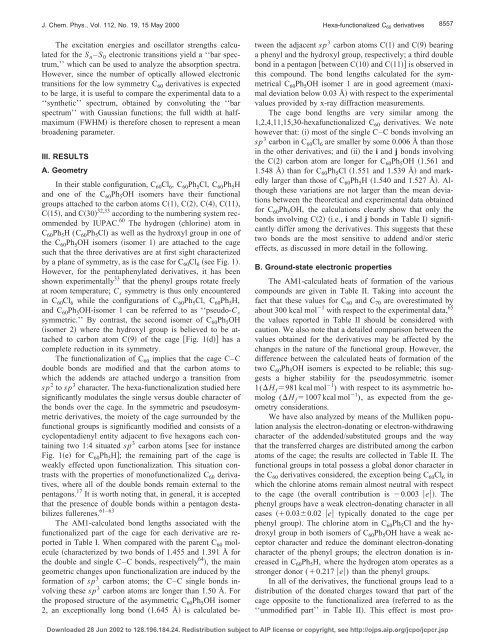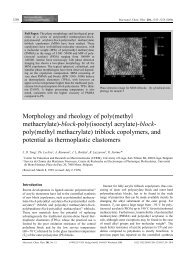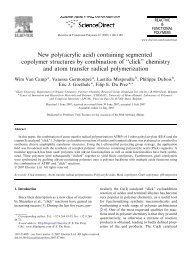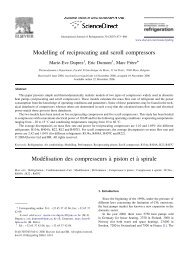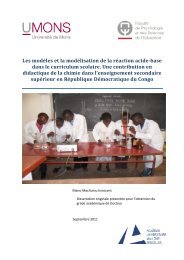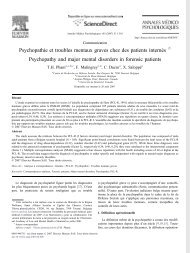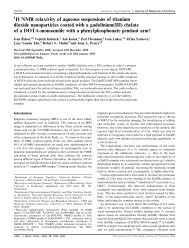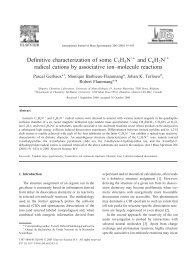Using JCP format - Université de Mons
Using JCP format - Université de Mons
Using JCP format - Université de Mons
You also want an ePaper? Increase the reach of your titles
YUMPU automatically turns print PDFs into web optimized ePapers that Google loves.
J. Chem. Phys., Vol. 112, No. 19, 15 May 2000 Hexa-functionalized C 60 <strong>de</strong>rivatives<br />
8557<br />
The excitation energies and oscillator strengths calculated<br />
for the S n – S 0 electronic transitions yield a ‘‘bar spectrum,’’<br />
which can be used to analyze the absorption spectra.<br />
However, since the number of optically allowed electronic<br />
transitions for the low symmetry C 60 <strong>de</strong>rivatives is expected<br />
to be large, it is useful to compare the experimental data to a<br />
‘‘synthetic’’ spectrum, obtained by convoluting the ‘‘bar<br />
spectrum’’ with Gaussian functions; the full width at halfmaximum<br />
FWHM is therefore chosen to represent a mean<br />
broa<strong>de</strong>ning parameter.<br />
III. RESULTS<br />
A. Geometry<br />
In their stable configuration, C 60 Cl 6 ,C 60 Ph 5 Cl, C 60 Ph 5 H<br />
and one of the C 60 Ph 5 OH isomers have their functional<br />
groups attached to the carbon atoms C1, C2, C4, C11,<br />
C15, and C30 32,33 according to the numbering system recommen<strong>de</strong>d<br />
by IUPAC. 60 The hydrogen chlorine atom in<br />
C 60 Ph 5 H(C 60 Ph 5 Cl) as well as the hydroxyl group in one of<br />
the C 60 Ph 5 OH isomers isomer 1 are attached to the cage<br />
such that the three <strong>de</strong>rivatives are at first sight characterized<br />
by a plane of symmetry, as is the case for C 60 Cl 6 see Fig. 1.<br />
However, for the pentaphenylated <strong>de</strong>rivatives, it has been<br />
shown experimentally 33 that the phenyl groups rotate freely<br />
at room temperature; C s symmetry is thus only encountered<br />
in C 60 Cl 6 while the configurations of C 60 Ph 5 Cl, C 60 Ph 5 H,<br />
and C 60 Ph 5 OH-isomer 1 can be referred to as ‘‘pseudo-C s<br />
symmetric.’’ By contrast, the second isomer of C 60 Ph 5 OH<br />
isomer 2 where the hydroxyl group is believed to be attached<br />
to carbon atom C9 of the cage Fig. 1d has a<br />
complete reduction in its symmetry.<br />
The functionalization of C 60 implies that the cage C–C<br />
double bonds are modified and that the carbon atoms to<br />
which the ad<strong>de</strong>nds are attached un<strong>de</strong>rgo a transition from<br />
sp 2 to sp 3 character. The hexa-functionalization studied here<br />
significantly modulates the single versus double character of<br />
the bonds over the cage. In the symmetric and pseudosymmetric<br />
<strong>de</strong>rivatives, the moiety of the cage surroun<strong>de</strong>d by the<br />
functional groups is significantly modified and consists of a<br />
cyclopentadienyl entity adjacent to five hexagons each containing<br />
two 1:4 situated sp 3 carbon atoms see for instance<br />
Fig. 1e for C 60 Ph 5 H; the remaining part of the cage is<br />
weakly effected upon functionalization. This situation contrasts<br />
with the properties of monofunctionalized C 60 <strong>de</strong>rivatives,<br />
where all of the double bonds remain external to the<br />
pentagons. 17 It is worth noting that, in general, it is accepted<br />
that the presence of double bonds within a pentagon <strong>de</strong>stabilizes<br />
fullerenes. 61–63<br />
The AM1-calculated bond lengths associated with the<br />
functionalized part of the cage for each <strong>de</strong>rivative are reported<br />
in Table I. When compared with the parent C 60 molecule<br />
characterized by two bonds of 1.455 and 1.391 Å for<br />
the double and single C–C bonds, respectively 64 , the main<br />
geometric changes upon functionalization are induced by the<br />
<strong>format</strong>ion of sp 3 carbon atoms; the C–C single bonds involving<br />
these sp 3 carbon atoms are longer than 1.50 Å. For<br />
the proposed structure of the asymmetric C 60 Ph 5 OH isomer<br />
2, an exceptionally long bond 1.645 Å is calculated between<br />
the adjacent sp 3 carbon atoms C1 and C9 bearing<br />
a phenyl and the hydroxyl group, respectively; a third double<br />
bond in a pentagon between C10 and C11 is observed in<br />
this compound. The bond lengths calculated for the symmetrical<br />
C 60 Ph 5 OH isomer 1 are in good agreement maximal<br />
<strong>de</strong>viation below 0.03 Å with respect to the experimental<br />
values provi<strong>de</strong>d by x-ray diffraction measurements.<br />
The cage bond lengths are very similar among the<br />
1,2,4,11,15,30-hexafunctionalized C 60 <strong>de</strong>rivatives. We note<br />
however that: i most of the single C–C bonds involving an<br />
sp 3 carbon in C 60 Cl 6 are smaller by some 0.006 Å than those<br />
in the other <strong>de</strong>rivatives; and ii the i and j bonds involving<br />
the C2 carbon atom are longer for C 60 Ph 5 OH 1.561 and<br />
1.548 Å than for C 60 Ph 5 Cl 1.551 and 1.539 Å and markedly<br />
larger than those of C 60 Ph 5 H 1.540 and 1.527 Å. Although<br />
these variations are not larger than the mean <strong>de</strong>viations<br />
between the theoretical and experimental data obtained<br />
for C 60 Ph 5 OH, the calculations clearly show that only the<br />
bonds involving C2 i.e., i and j bonds in Table I significantly<br />
differ among the <strong>de</strong>rivatives. This suggests that these<br />
two bonds are the most sensitive to ad<strong>de</strong>nd and/or steric<br />
effects, as discussed in more <strong>de</strong>tail in the following.<br />
B. Ground-state electronic properties<br />
The AM1-calculated heats of <strong>format</strong>ion of the various<br />
compounds are given in Table II. Taking into account the<br />
fact that these values for C 60 and C 70 are overestimated by<br />
about 300 kcal mol 1 with respect to the experimental data, 65<br />
the values reported in Table II should be consi<strong>de</strong>red with<br />
caution. We also note that a <strong>de</strong>tailed comparison between the<br />
values obtained for the <strong>de</strong>rivatives may be affected by the<br />
changes in the nature of the functional group. However, the<br />
difference between the calculated heats of <strong>format</strong>ion of the<br />
two C 60 Ph 5 OH isomers is expected to be reliable; this suggests<br />
a higher stability for the pseudosymmetric isomer<br />
1(H f 981 kcal mol 1 ) with respect to its asymmetric homolog<br />
(H f 1007 kcal mol 1 ), as expected from the geometry<br />
consi<strong>de</strong>rations.<br />
We have also analyzed by means of the Mulliken population<br />
analysis the electron-donating or electron-withdrawing<br />
character of the ad<strong>de</strong>n<strong>de</strong>d/substituted groups and the way<br />
that the transferred charges are distributed among the carbon<br />
atoms of the cage; the results are collected in Table II. The<br />
functional groups in total possess a global donor character in<br />
the C 60 <strong>de</strong>rivatives consi<strong>de</strong>red, the exception being C 60 Cl 6 in<br />
which the chlorine atoms remain almost neutral with respect<br />
to the cage the overall contribution is 0.003 e. The<br />
phenyl groups have a weak electron-donating character in all<br />
cases 0.030.02 e typically donated to the cage per<br />
phenyl group. The chlorine atom in C 60 Ph 5 Cl and the hydroxyl<br />
group in both isomers of C 60 Ph 5 OH have a weak acceptor<br />
character and reduce the dominant electron-donating<br />
character of the phenyl groups; the electron donation is increased<br />
in C 60 Ph 5 H, where the hydrogen atom operates as a<br />
stronger donor (0.217 e) than the phenyl groups.<br />
In all of the <strong>de</strong>rivatives, the functional groups lead to a<br />
distribution of the donated charges toward that part of the<br />
cage opposite to the functionalized area referred to as the<br />
‘‘unmodified part’’ in Table II. This effect is most pro-<br />
Downloa<strong>de</strong>d 28 Jun 2002 to 128.196.184.24. Redistribution subject to AIP license or copyright, see http://ojps.aip.org/jcpo/jcpcr.jsp


